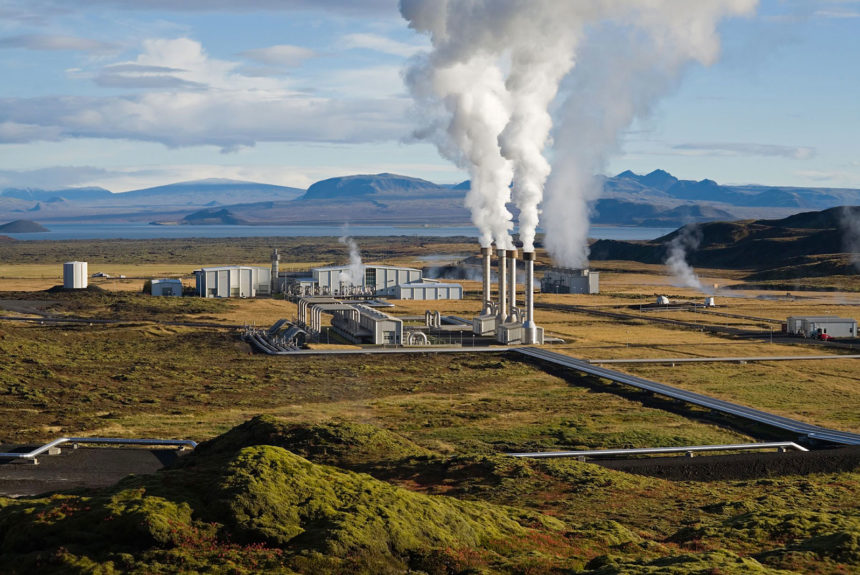By Kelvey Vander Hart
Looking at the makeup of America’s renewable energy portfolio, a few listed energy sources are easily recognizable. After all, most Americans have, at some point, seen a wind turbine or a solar panel with their own eyes. But there is a growing source of renewable energy that is not as familiar: geothermal.
How Does Geothermal Energy Work?
For those unfamiliar with geothermal energy, it is simply heat derived from the earth’s core. Geothermal energy is commonly tapped in one of two ways. The first is through power plants, which draw on heat from deep inside the earth to generate electricity. The second is by using heat pumps, which draw heat from close to the surface of the earth in order to power smaller spaces, like homes and businesses. This explainer from the EPA shows how both of these are built and work.
This type of energy is endlessly renewable (as the earth’s core will always be emitting heat) and available 365 days a year, 24 hours a day. The availability of energy is also very high. Energy availability is essentially the amount of time a power plant can generate electricity during a certain timeframe, divided by the total amount of time in that period. While traditional coal plants have about a 75 percent availability, geothermal usually has availability of 90 percent or more.
Geothermal energy is able to be extracted without the use of any fossil fuels, which makes is a very clean source of power. These power plants produce virtually no emissions, with Mt. Princeton Geothermal, LLC noting that a 100 megawatt geothermal power generator would annually offset 190,000 pounds of nitrogen dioxide and sulfur dioxide in comparison to natural gas. Also in comparison to natural gas, this same generator would eliminate 780 million pounds of carbon emissions.
Innovation Leading The Way
What causes renewable energy sources like geothermal to grow? It is not because of any government intervention, but because of the innovation that the free-market drives. Take, for example, FERVO Energy, a company that is working to unlock new techniques in developing geothermal energy.
FERVO takes a unique approach to drilling for geothermal energy plants. They use horizontal drilling in tandem with fiber optic sensing. These two things not only increase the lifetime and productivity of the wells drilled for geothermal plants but allow for this power source to be tapped in new places. FERVO estimates that through their approach, 100 gigawatts of new geothermal energy is accessible in the United States.
It is this type of innovation that will expand the availability of geothermal energy while making it more affordable than ever. The Department of Energy notes that most of the cost of geothermal is found in early expenses, not necessarily ongoing operational costs. As new techniques make it less expensive to build geothermal plants, the affordability down the line will also increase.
Government Roadblocks
One of the biggest barriers to market-driven growth of geothermal energy are the roadblocks placed by the government. Because of the fact that there is a drilling component involved in building geothermal power plants, many archaic regulations remain in place, regulating the process similarly to the drilling done by the oil and gas industry.
The Bureau of Land Management (BLM), in particular, governs geothermal energy generation under the Federal Land Policy and Management Act and the National Environmental Policy Act (NEPA). Under NEPA, BLM regards the exploratory wells drilled during the geothermal construction process as, “more technically demanding than conventional oil and gas wells.” While recent BLM testimony in front of Congress points to a willingness to streamline some of these regulations to make the process simpler, faster, and more affordable, this is just one of the many hurdles the geothermal industry must get past.
Geothermal plays an important role in the makeup of America’s renewable energy portfolio. If the government steps out of the way of the free-market, it will rapidly grow. Innovation in geothermal energy is simply more proof that it is the market, not government, that is paving the way forward to a future powered by carbon-free electricity.
Kelvey Vander Hart is a native Iowan, a member of the American Conservation Coalition, and a communications specialist at Reason Foundation.
The views and opinions expressed are those of the author’s and do not necessarily reflect the official policy or position of C3.
